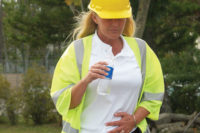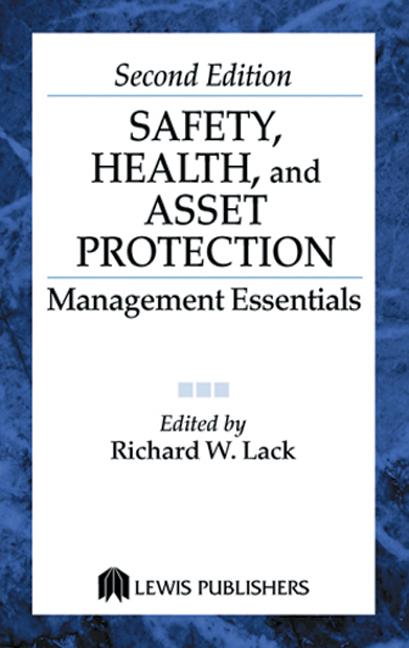 Whether you work in a hot smelting plant or outdoors in the summer months, heat exposure can be dangerous. Workers who are exposed to extreme heat or work in hot environments may be at increased risk of heat stress. In foundries, steel mills, bakeries, smelters, glass factories, and furnaces, extremely hot or molten material is the main source of heat. For people working outdoors in jobs such as construction, road repair, open-pit mining and agriculture, summer sunshine provides the hot environment. In laundries, restaurant kitchens, and canneries, high humidity adds to the heat burden. In all cases, the cause of heat stress is a working environment which can potentially overwhelm your body's ability to deal with heat.
Whether you work in a hot smelting plant or outdoors in the summer months, heat exposure can be dangerous. Workers who are exposed to extreme heat or work in hot environments may be at increased risk of heat stress. In foundries, steel mills, bakeries, smelters, glass factories, and furnaces, extremely hot or molten material is the main source of heat. For people working outdoors in jobs such as construction, road repair, open-pit mining and agriculture, summer sunshine provides the hot environment. In laundries, restaurant kitchens, and canneries, high humidity adds to the heat burden. In all cases, the cause of heat stress is a working environment which can potentially overwhelm your body's ability to deal with heat.
"Heat stress" is a buildup of body heat generated from a combination of the effort you exert while working, the environment (air temperature, humidity, air movement, radiation from the sun, or hot surfaces/sources), and the clothing and equipment you wear.
Most people feel comfortable when the air temperature is between 20°C and 27°C and the when relative humidity ranges from 35 to 60%. When air temperature or humidity is higher, you may feel uncomfortable but your body can cope with a little extra heat. However, very hot environments can increase your internal body temperature several degrees above the normal temperature of 37°C, overwhelming your body's natural cooling systems and leading to a variety of serious and possibly fatal conditions.
Illnesses caused by heat exposure
The risk of heat-related illness is different for each person. You are at greater risk of heat stress if you have pre-existing health issues (e.g. are overweight, have heart disease, high blood pressure, or respiratory disease), are 65 years of age or older, or you take medications that may be affected by extreme heat. Also, you may be more susceptible to heat if you have skin diseases or rashes.
Heat stress puts workers at risk for illnesses such as heat cramps, heat syncope, heat exhaustion, and heat stroke. Heat can also lead to accidents resulting from the slipperiness of sweaty palms, and from accidental contact with hot surfaces. As a worker moves from a cold to a hot environment, fogging of eye glasses can briefly obscure vision, presenting a safety hazard. The first step in preventing them is learning more about heat illnesses and how they can impact your health.
Heat cramps are sharp pains in the muscles that occur when there is a salt imbalance in your body from not replacing salt lost with sweat. Cramps occur most often when you drink large amounts of water without enough salt (electrolyte) replacement. You may experience heat cramps alone or combined with one of the other heat stress illnesses.
Heat syncope occurs when you feel dizzy, light headed or faint suddenly and lose consciousness due to low blood pressure. It can be caused by blood pooling in the legs if you have been standing still for a long time in a hot environment, or by the loss of body fluids through sweating. Your risk of developing heat syncope increases when you have not adjusted (acclimated) to a hot environment or are dehydrated. Resting in a cool area usually brings about a quick recovery.
Heat exhaustion is caused when you lose body water and salt through excessive sweating. Signs and symptoms of heat exhaustion include: heavy sweating, weakness, dizziness, visual disturbances, intense thirst, nausea, headache, vomiting, diarrhea, muscle cramps, breathlessness, palpitations, tingling and numbness of the hands and feet. People usually recover after resting in a cool area and drinking cool salted drinks (e.g. sports drinks).
Heat stroke and hyperpyrexia (elevated body temperature) are the most serious types of heat illnesses and require immediate first aid and medical attention. Signs of heat stroke include body temperature of more than 41°C, and complete or partial loss of consciousness. The signs of heat hyperpyrexia are similar except that your skin remains moist. Sweating is not a reliable symptom of heat stress because there are two types of heat stroke - "classical" heat stroke where there is little or no sweating (usually occurs in children, the chronically ill, and the elderly), and "exertional" heat stroke where body temperature rises because of strenuous exercise or work and you do sweat. Heat stroke can cause death or permanent disability if emergency treatment is delayed or not given.
Prevention tips for employers
Every year, Canadian workers die on the job because of heat-related causes. As an employer you must manage this risk - evaluate the situation and determine appropriate controls. Depending on the workplace, a heat stress control program may be necessary. You can help reduce the risk by managing work activities so that they match the employee's physical condition and the temperature.
Provide training. Take time to train your workers on the serious health risks of heat illness, how to avoid it, how to recognize the symptoms and what to do if it happens.
Keep workers cool and hydrated. Demonstrate your commitment to worker health by allowing some flexibility in work arrangements during hot conditions. If possible, schedule heavy tasks, and work that requires personal protective equipment, for cooler times such as early mornings or evenings. Keep the work area cool, or provide air-conditioned rest areas. For workers on duty in the heat, provide plenty of water and encourage them to drink even if they don't feel thirsty, and to take frequent rest breaks.
Prevention tips for workers
Acclimate. Do not expect to tolerate the heat right away. It can take up to two weeks to build up a tolerance (acclimate) to working in hot conditions. Adapt your work and pace to the temperature and how you feel.
Take breaks. A simple but potentially life-saving practice, taking a break to cool off in the shade or in an air-conditioned building or vehicle helps prevent your body from overheating. If you don't have a shady or cool place, reduce your physical efforts.
Keep cool. Stay out of the sun as much as possible. If your job includes some physically demanding tasks, try to save those for the early morning or late afternoon hours when the sun is less intense. Wear lightweight clothing and a hat. The risk of heat illness can be greater if you wear certain types of personal protective equipment. If necessary, consider also wearing a cooling vest to help keep your body temperature down.
Stay hydrated. This is essential. As a general guideline, drink one cup of water every 15 to 20 minutes, whether you are thirsty or not.
Avoid alcohol and drugs. They can worsen the effects of heat illness. If you are on medication, read the label or talk to your doctor to understand how it might cause your body to react to the sun and heat.
Recognize the symptoms of heat stress in yourself and your co-workers. These symptoms include rash, cramping, fainting, excessive sweating, headache and dizziness. You may not see or feel the effects so always use the buddy system to monitor one another.
Heat illness is a serious but easily preventable health risk.
Source: Canadian Centre for Occupational Health and Safety www.ccohs.ca


